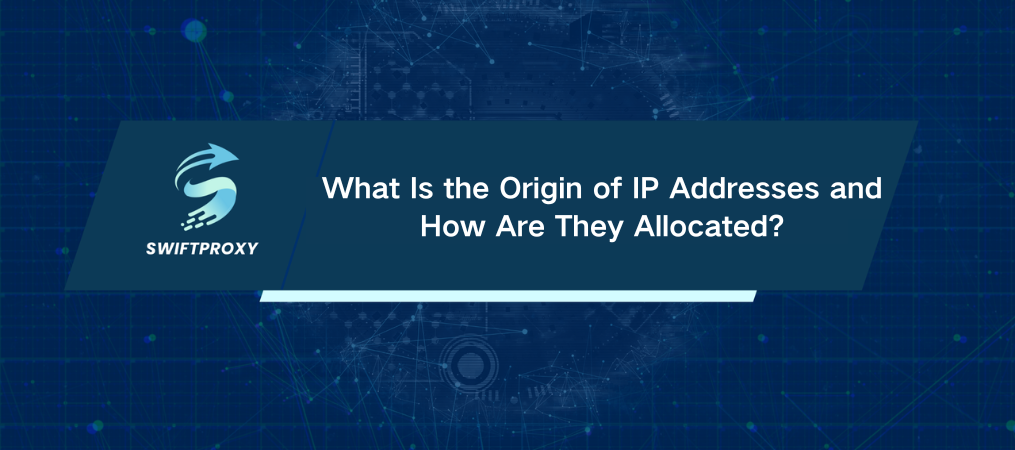What Is the Origin of IP Addresses and How Are They Allocated?

In this blog, we will explore the origins of IP addresses and how they are assigned. There are two main types of IP addresses: IPv4 and IPv6. Although IPv4 remains the dominant protocol on the internet, the IPv6 is becoming increasingly recognized and utilized.
Introduction to IP Addresses
In the early days of the internet, a variety of protocols were used to enable communication between computers. Over time, IPv4 became the most widely adopted and established as the standard protocol.
In the years that followed, the internet underwent a revolutionary expansion, with user growth far exceeding initial expectations. Experts soon recognized that the 32-bit IPv4 format, which provides only 4 billion addresses (ranging from 0.0.0.0 to 255.255.255.255), would quickly become insufficient given the rapid increase in internet-connected devices. This scarcity of addresses prompted the need for a new solution.
This is where IPv6 comes into play. As a 128-bit protocol, IPv6 offers an incredible theoretical total of 340 undecillion unique IP addresses. This vast number is far more than necessary to meet the web's needs for an extraordinarily long time.
However, adoption of IPv6 has been slow since its introduction. The main reason is that IPv4 and IPv6 are not backward compatible, meaning that software designed for IPv4 cannot function with IPv6. This incompatibility is also why some websites do not yet support IPv6.
These factors have led to the rise in IPv4 prices and the adoption of technologies like NAT (Network Address Translation). NAT allows ISPs to assign a single IP address to multiple devices. This means that a large group of users can share the same IP address. Consequently, these IP addresses are almost impossible to blacklist, as blocking one IP would also block thousands of legitimate users, including those who might be using bots.
IP allocation method
IANA, the Internet Assigned Numbers Authority, is responsible for allocating IP addresses to regional registries. These registries then distribute the IP addresses to ISPs (Internet Service Providers) such as AT&T, Verizon, and Comcast.
ISPs receive IP addresses along with an associated ASN, or Autonomous System Number. The ASN helps to link a specific IP address or range of IP addresses to a particular ISP, aiding in tracking the ownership of IPs.
While an ISP can have multiple ASNs, each ASN is assigned to only one ISP and can be associated with only one company.
However, large ISPs are typically comprised of multiple companies, which means they frequently hold multiple ASNs.
These ISPs then lease or rent IP addresses to end-users. Websites like whatismyip.com can help you determine which ISP owns your IP address.
The Data of IP Geolocation
Every IP address globally is associated with a geographical location to help websites and advertisers provide more targeted content, even without direct access to GPS data.
Several companies specialize in managing IP geolocation data, as locations can change over time. Notable providers include DigitalElement and MaxMind, while major tech companies like Facebook and Google also maintain their own geolocation databases.
Keep in mind that these companies are independent private entities, not a central authority responsible for collecting geolocation data. This lack of centralization can lead to inaccuracies, which is why you might see varying results from different IP check websites and sometimes receive geolocation information that places you far from your actual location, although the country is typically correct.
Major technology companies such as Facebook, Google, and Amazon have access to more comprehensive data and utilize advanced techniques for tracking IP geolocation, resulting in generally more accurate information.
The Quality IP Address
Many companies, including Facebook and Google, also monitor all traffic associated with specific IP addresses.
Essentially, everything you do online is monitored and tied to your IP. Given that most IP addresses have been used at least once before, finding a completely "clean" or unused IP is almost impossible.
The situation is further complicated by the fact that ISPs typically allocate IP addresses in blocks. This means that residential proxy providers must ensure that the traffic generated by these IPs appears natural and must be extremely cautious to avoid having the entire IP subnet blacklisted.
Additionally, many ISPs sell their data to major tech companies, which provide detailed information about which company owns each IP address.
A quality IP address is characterized by:
· Being owned by an ISP that does not sell its data to major tech companies.
· Being officially rented to an individual user (not a company) by the ISP.
· Generating consistently real, organic traffic and never having been blacklisted.
Such an IP is often referred to as a true residential IP.
Alternatively, the high quality IPs are those assigned to a vast number of users simultaneously through CGNAT (Carrier-Grade NAT). This results in the IP being inundated with traffic from many users, making it clear to monitoring technology companies that the IP is utilized by hundreds or even thousands of individuals at the same time.
This strategy allows your traffic to blend into a massive flow of data, making the IP nearly immune to blacklisting, as blocking it would affect a large number of legitimate users.
While your accounts might get banned, the IP itself remains protected from being banned. Additionally, because these are mobile IPs, you can quickly reconnect to the network to obtain a new IP within seconds.
Conclusion
Reading this article will give you a clearer understanding of IP addresses and proxies, helping you distinguish between high-quality and less reliable IP addresses. Swiftproxy residential proxies come from real users, ensuring high-quality and reliable IP addresses. If you have any needs, please contact us.

















































